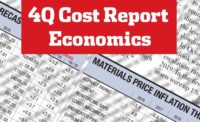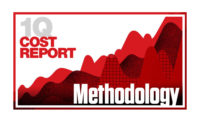Q4 Cost Report: Europe’s Growth Pushes Prices
Inflationary pressures are growing across Europe as construction demand rises at the fastest rate since 2006, says the Euroconstruct alliance of economic forecasters from 19 countries.
All reported volume to grow in those countries in 2017 for the first time since the early 1990s, increasing 3.5%, although it is set to slow to 2.6%, 2.1% and 1.1%, respectively, in the next three years.
Germany was the region’s largest market last year, with more than 20% of total output. The U.K. and France followed, with 14% each, says Euroconstruct. Citing a European Commission forecast earlier this year, project cost consultant Rider Levett Bucknall says construction “only really started to recover “ in 2016 from past financial crises. The firm sees construction investment in Europe up 3.5% in 2018 compared to 2.8% in 2017.
Germany’s long run of construction growth continues, says Heinrich Weitz, head of economic affairs at construction group Hauptverband der Deutschen Bauindustrie. Demand is up in 2017 in commercial and public-works sectors by 5.3% and 7.4%, respectively. Price rises have been modest at 1%, but, in 2017, construction inflation “has really started—the first time we’ve had significant rises since 2011,” he says. In this hot market, executives see skilled-labor shortages as their biggest threat, Weitz adds.
In the U.K., Brexit talks with the European Union are coloring all aspects of its economy. Construction demand now is “tentative,” says Will Waller, Arcadis associate director. Commercial work is declining, and, despite ambitious long-term infrastructure plans, “there is concern about the short term,” he adds. As some contractors target less risky projects, “competitive tension” is rising, Waller says.
Falling U.K. currency value since the 2016 Brexit vote continues to pump import price inflation. Britain imports about 30% of its construction materials, 60% from the EU, he says, noting a 5% price rise and the potential of inflation reaching 20% for imported items such as curtain walling.
Potential new Brexit-generated tariffs, customs controls and logistical disruptions replacing the currently open EU marketplace also are set to inflate costs, by up to 3%, says Waller. However, “we haven’t seen any solid sign that labor that’s already here is returning to the EU,” he adds.
The restrictions also could inflate costs in a booming but labor-underresourced market in the Irish Republic, which remains in the EU, says Kevin James, managing director of Irish cost consultant Cogent Associates. In Dublin, price pressure is highest and bid price inflation is “a challenge,” he says.
In the EU’s northern end, short-staffed contractors in Sweden’s growing market “are slowly raising their prices,” says Dennis Bognar, a senior cost analyst at ÅF Consult.
In the south, infrastructure public investment in Spain remains constrained by government policy, resulting in stable prices but with signs of upward movement, says Ignacio Menendez, a partner in APM Management.
As the Spanish market continues recovering from its banking crisis falloff, local shortages of skilled workers are attracting migrant labor from abroad, including Romania and Latin America, he says. In the 12 months from early 2016, employment in the sector rose by nearly 5%.
In Poland’s strengthening economy, the construction market “is starting to heat up to some extent,” says Jan Holyst, a Warsaw-based partner in regional cost consultant Sentient Group. Bid prices “are rising rapidly … particularly in the past two quarters,” he says, and subcontractors are less able to commit to projects. Bid prices have risen 10% in the last year, and he expects further increases, continuing into 2018.
In Turkey, while national and regional political turmoil depresses commercial demand, gas prices are rising, says Selçuk Alten, vice president of consultant Proje Geliştirme ve Yönetim A.S.c.




